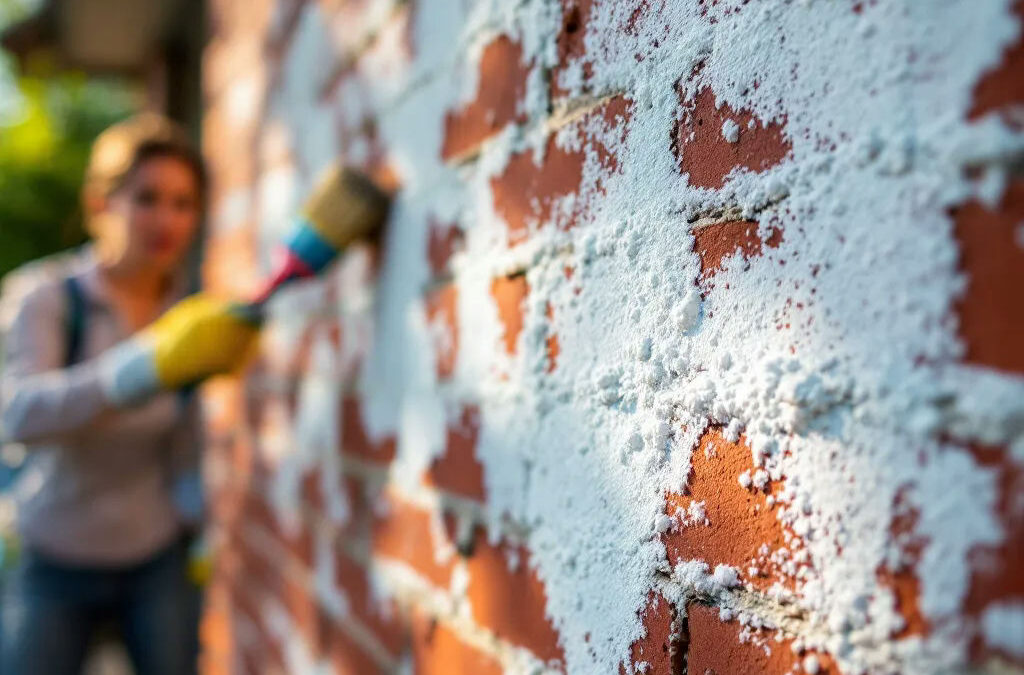I. Introduction
Efflorescence is a white, powdery substance that appears on brick surfaces due to the crystallization of soluble salts. It often signals underlying moisture problems that, if not addressed, can compromise the integrity of the bricks and the structure itself. Effectively managing efflorescence not only enhances the aesthetic appeal of brick surfaces but also safeguards against potential damage caused by prolonged moisture exposure.
II. Understanding Efflorescence
Causes of Efflorescence in Bricks
Efflorescence primarily occurs when moisture infiltrates the bricks, bringing along soluble salts that are found in the bricks or mortar. Once the moisture evaporates, these salts become concentrated and form the characteristic white residue on the surface. Inadequate drainage, poor installation, and environmental factors can all contribute to this issue, making it essential to recognize the sources of moisture to effectively prevent efflorescence.
To better understand moisture issues in large-scale projects, explore our guide on Pre-Pour Checklist for Large Commercial Concrete Jobs.
Visual Characteristics of Efflorescence
Visually, efflorescence appears as white or light-colored powdery stains on brick surfaces. These deposits can vary in size from small patches to extensive areas covering entire walls. It’s crucial to recognize these signs early, as they can indicate significant moisture infiltration and potential damage to the bricks beneath the surface.
Common Areas Where Efflorescence Occurs
Efflorescence is particularly common in areas that are prone to moisture exposure, such as basements, exterior walls, and chimneys. Locations where bricks are in direct contact with soil, or where water runoff accumulates, are especially susceptible. Being aware of these common areas can help homeowners proactively address moisture management strategies.
For commercial applications, we recommend reviewing the Differences Between Residential and Commercial Concrete Applications.
III. Prevention of Efflorescence
A. Proper Brick Installation
To prevent efflorescence, the choice of bricks and mortar is vital. Opting for high-quality, dense bricks can reduce absorption of moisture and salts. Similarly, using proper mortar mixes ensures a strong bond that withstands moisture infiltration, significantly lowering the risk of efflorescence forming in the first place.
Learn more about avoiding issues during construction by reading Top 7 Mistakes to Avoid in Commercial Concrete Construction.
B. Moisture Control
Maintaining effective moisture control is key to preventing efflorescence from developing. Installing proper drainage systems redirects water away from brick surfaces, minimizing moisture contact. Additionally, using vapor barriers during construction can further limit moisture penetration, protecting the integrity of the bricks over time.
Consider reviewing What to Expect During a Commercial Concrete Installation Project for more details on proper drainage setup.
C. Sealants
Applying effective sealants designed for brick can significantly mitigate the occurrence of efflorescence. These sealants create a protective barrier that prevents water ingress while still allowing the bricks to breathe. It’s important to apply these products according to the manufacturer’s instructions and to reapply them periodically, as recommended, to maintain their effectiveness.
For improved material choices, check out How to Choose the Right Concrete Mix for Your Commercial Project.
D. Landscaping Considerations
Landscaping can play a significant role in efflorescence prevention. Grading soil around brick structures to ensure proper water runoff is crucial to reduce moisture retention near bricks. Choosing appropriate plants and irrigation systems that minimize water saturation near brick walls further helps in maintaining dryness and prevents the crystallization of salts.
Related read: How Weather Affects Commercial Concrete Pours.
IV. Removal of Efflorescence
A. Initial Assessment
Before attempting to remove efflorescence, it’s essential to assess its severity. Use visual inspection to identify the extent of the deposits and whether they are localized or widespread. This assessment will guide the appropriate removal method and ensure that effective steps are taken to address the underlying moisture problem.
B. Dry Brushing Technique
The dry brushing technique is a simple but effective method for removing efflorescence. Start by gathering tools such as a stiff-bristled brush, protective gloves, and a dust mask to safeguard against inhaling dust. Gently brush affected areas to remove the powdery substance without damaging the underlying brick, and dispose of the residue properly afterward.
C. Chemical Cleaners
For more stubborn efflorescence, chemical cleaners specifically designed for brick surfaces may be necessary. Options include acidic or alkaline solutions that dissolve salt deposits. Always prioritize safety by wearing protective gear, and follow the application instructions carefully to avoid damaging the brick or surrounding areas.
To ensure safe worksite conditions, refer to Key Safety Measures for Commercial Concrete Pours.
D. Re-Application of Sealants
After removing efflorescence, it’s crucial to reapply sealants to protect the brick surfaces. Ensure the bricks are completely dry before application to avoid trapping moisture beneath the sealant layer. Ongoing maintenance, including regular monitoring and reapplication of sealants, will help prevent future efflorescence issues.
We recommend understanding the role of reinforcement as well, by reading The Importance of Reinforcement in Commercial Concrete Work.
V. Long-term Maintenance of Brick Surfaces
Routine inspections are paramount for the long-term maintenance of brick surfaces. Regularly check for signs of moisture damage, efflorescence, and other deterioration. Additionally, ensure that drainage systems remain effective and that landscaping remains conducive to keeping bricks dry, which collectively aids in prolonging the life and appearance of brick surfaces.
For better ongoing results, explore our guide on Understanding Curing Times for Commercial Concrete Projects.
VI. Conclusion
Preventing and addressing efflorescence is vital for maintaining the beauty and integrity of brick surfaces. By employing proper installation techniques, managing moisture effectively, and performing regular maintenance, homeowners can enjoy the longevity and aesthetic appeal of their brick structures. Taking proactive steps not only enhances the home’s appearance but also safeguards against costly repairs down the line.
Call us today at 916-562-2345 to speak with a professional and get a free quote. Don’t wait until efflorescence turns into serious damage — let us help you protect your property now.


